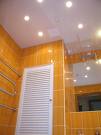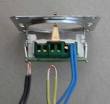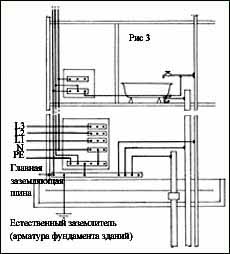Requirements for electrical equipment and wiring in bathrooms, showers and utility rooms
 Premises saturated with plumbing equipment (bathrooms, showers, toilets, kitchens), from the point of view Electrical safety most often refer to places of increased danger or even particularly dangerous. In this regard, it is very important to strictly follow the rules for installing electrical installations.
Premises saturated with plumbing equipment (bathrooms, showers, toilets, kitchens), from the point of view Electrical safety most often refer to places of increased danger or even particularly dangerous. In this regard, it is very important to strictly follow the rules for installing electrical installations.
Premises with increased danger are characterized by the presence in them of one of the following conditions:
- moisture (relative humidity above 75%) or conductive dust;
- conductive floors (metal, soil, reinforced concrete, bricks, etc.);
- high temperature (more than 35o);
- the ability of a person to simultaneously touch the metal structures of the building, technological devices, mechanisms, etc., connected to the ground, on the one hand, and to the metal casings of electrical equipment, on the other.
Particularly dangerous premises are characterized by the presence of one of the following conditions:
- special humidity (relative humidity is close to 100%);
- chemically active or organic medium;
- two or more conditions of increased danger at the same time.
it should be noted that PUE and other regulatory electrotechnical documents in connection with Russia's entry into the International Electrotechnical Commission have already undergone and are undergoing significant changes. Therefore, only the latest editions of these regulations should be used.
 Bathrooms and toilets, showers, toilets, as a rule, fall into the classification of rooms with increased danger or even particularly dangerous rooms.
Bathrooms and toilets, showers, toilets, as a rule, fall into the classification of rooms with increased danger or even particularly dangerous rooms.
From the point of view of electrical safety, a person is a conductor of electric current. Electrical resistance of the body is mainly provided by the upper stratum corneum, which has no blood, lymphatic and other vessels and nerve endings, and depends on the moisture content of the skin, the location and size of the contact surface of the body with the current-carrying part of electrical equipment, the distance between the contacts, the flow path of current through the body, the individual characteristics of the body and other factors.
The resistance of human skin can reach several thousand and even tens of thousands of ohms, the resistance of internal organs - several hundred ohms. Sometimes, when determining electrical safety conditions, it is assumed that the average resistance of the human body is about 1000 ohms.
Lethal current for a person is considered 0.1 A, dangerous - half of this value, i.e. 0.05 A.
Of the many electrical safety measures for this story, the following are important:
- application of safe voltages;
- protective separation of networks;
- protective grounding and grounding;
- protective shutdown;
- control over the state of isolation;
- the use of double insulation;
- implementation of the equipotential bonding system.
 In accordance with the above-mentioned rules and measures, in places with high ambient temperatures, as well as in humid and especially humid rooms, wires, cables and their fastening structures should be used with increased heat resistance and moisture resistance, respectively (PUE, clauses 2.1.42, 2.1.43).
In accordance with the above-mentioned rules and measures, in places with high ambient temperatures, as well as in humid and especially humid rooms, wires, cables and their fastening structures should be used with increased heat resistance and moisture resistance, respectively (PUE, clauses 2.1.42, 2.1.43).
When wires and cables intersect with pipelines, the clear distance between them must be at least 50 mm, and with pipelines containing flammable or combustible liquids and gases, at least 100 mm.
Wires and cables must be additionally protected from mechanical damage with a length of at least 250 mm on each side of the pipeline. When crossing hot pipelines, wires and cables must be protected from the effects of high temperatures or designed accordingly.
When laying in parallel, the distance from wires and cables to pipelines should be at least 100 mm, and to wires with flammable or combustible liquids and gases — at least 400 mm.
Wires and cables laid parallel to hot pipes must be protected against high temperatures or designed accordingly.
Pipes, ducts and flexible metal hoses of electrical wiring must be laid so that moisture does not accumulate in them (PUE, clauses 2.1.56, 2.1.57, 2.1.63).
Wiring is a set of wires and cables with associated fasteners (PUE, point 2.1.2). It is not allowed to lay cables and wires in ventilation chambers and sanitary ventilation ducts. Only the crossing of chambers and channels with wires and cables laid in steel pipes is allowed (PUE, point 5.1.32).
 In bathrooms, showers and toilets of private houses, hidden electrical wires must be used, and in kitchens - the same types of electrical wires as in living rooms. Of particular note is a significant change in the rules that concerns zero working wires (N) and neutral protective conductors (PE), the latter of which serve exclusively for protective earthing and are essential to ensure electrical safety.
In bathrooms, showers and toilets of private houses, hidden electrical wires must be used, and in kitchens - the same types of electrical wires as in living rooms. Of particular note is a significant change in the rules that concerns zero working wires (N) and neutral protective conductors (PE), the latter of which serve exclusively for protective earthing and are essential to ensure electrical safety.
According to the new rules, in residential and public buildings, the lines of the group network from the group panels to the plugs, as well as the power supply of stationary single-phase electrical receivers, must be carried out with three conductors: phase, zero working and zero protective conductors (PUE, point 7.1 .36). The internal electrical equipment of the premises under consideration also has its own characteristics.
There are the following classes differing in the method of protection against electric shock.
Class 0 equipment… Protection against electric shock is provided by basic insulation.
Class I equipment... Protection is provided by basic insulation and the connection of exposed conductive parts that can be touched with the protective conductor of the fixed wiring.
Class II equipment… Protection is provided by the use of double or reinforced insulation.
Class III equipment… Protection against electric shock is based on a safe extra low voltage supply. (For details see GOST R IEC 536-94).
In bathrooms, showers and similar rooms, only electrical equipment specially designed for installation in the relevant areas in accordance with GOST R 50571.11-96 (fig. 1 and 2) should be used.

So in zone 0, electrical appliances with a voltage of up to 12 V (class III) intended for use in a bathtub can be used, and the power source must be located outside this zone.
In zone 1, only boilers can be installed, in zone 2 - boilers and lamps of protection class II, in zones 0, 1 and 2 it is not allowed to install distribution boxes, distribution devices and control devices (PUE, point 7.1. 47).
 In bathrooms, shower cabins and toilets of a separate house, the casings of the lighting fixtures must be made of insulating material. It is not allowed to install sockets and switches in bathrooms, showers, dressing rooms of showers and in soap baths, steam baths, laundry rooms of laundry rooms.
In bathrooms, shower cabins and toilets of a separate house, the casings of the lighting fixtures must be made of insulating material. It is not allowed to install sockets and switches in bathrooms, showers, dressing rooms of showers and in soap baths, steam baths, laundry rooms of laundry rooms.
In zone 3, it is allowed to install sockets connected to the mains through isolation transformers or protected by residual current devices.
Sockets must be as far as possible from pipelines, and from gas pipelines - at least 500 mm.
All switches and sockets must be located at least 0.6 m from the shower door. (PUE, clauses 7.1.48; 7.1.50).
In washrooms in zones 1 and 2, it is allowed to install cable-operated switches (PUE, clause 7.1.52).
Residual current devices (RCDs) provide a high degree of protection for people from electric shock in direct and indirect contact, and also reduce the risk of fire in electrical installations.
Residual current devices, as a rule, are installed in group lines, feeding plugs. In bathrooms, however, it is recommended to use them in lines supplying permanently installed equipment and lamps.
For plumbing cabins, baths and showers, if one group line is allocated to them, the tripping current of the RCD is set to 10 mA, in other cases it is allowed to use an RCD with a tripping current of up to 30 mA.
In rooms with increased danger and especially dangerous, such electrical safety measures as grounding, grounding and equalization of potential… For this purpose, a potential equalization system must be installed at the entrance of the building by electrically combining the following conductive parts (Fig. 3):

- main (main) protective conductor;
- main (trunk) ground wire or main ground clamp;
- steel pipes for communications within buildings and between buildings;
- metal parts of building structures, lightning protection, central heating, ventilation and air conditioning systems.
During the transmission of electricity, it is recommended to carry out additional potential equalization systems again (PUE, point 7.1.87). All exposed parts of stationary electrical installations, conductive parts of third parties and neutral protective conductors of all electrical equipment (including sockets) must be connected to them.
An additional equipotential bonding system is mandatory for bathrooms and showers (Fig. 3).
If even in these rooms there is no electrical equipment with neutral protective conductors connected to the equipotential bonding system, then an additional equipotential bonding system must be connected to the PE bus (terminal) of the switchboard or at the entrance.
When using a "warm" floor, the heating elements embedded in the floor must be covered with a grounded metal mesh or a grounded metal sheath connected to the potential equalization system (PUE, clause 7.1.88). In this regard, it should be said that washing machines, which are often installed in bathrooms, must have double insulation, and if there is none, then the metal body of the machine must be grounded through the neutral protective conductor (PE).
So, in baths and saunas, metal bath bodies and in shower cabins, metal trays must be connected by metal wires to metal water pipes to equalize the potentials of the elements of the system.
In addition, it should be noted that the distribution rooms, as well as the introduction and distribution boards of a separate house, cannot be located under toilets, bathrooms, showers, sinks, washing machines and steam rooms.
Pipelines (water supply, heating, sewage, internal ducts), ventilation and other ducts laid through the distribution rooms (except for a branch to the heater of the distribution room itself) should not have branches in the room, as well as hatches, valves, flanges, revision valves, etc. The laying of gas pipelines or pipelines with flammable liquids through these premises is not allowed (PUE, point 7.1.29).
